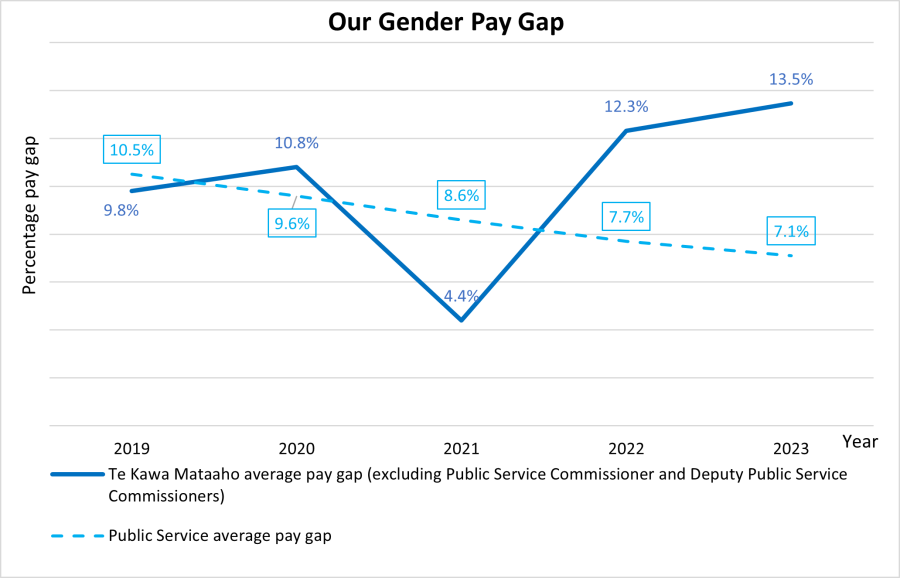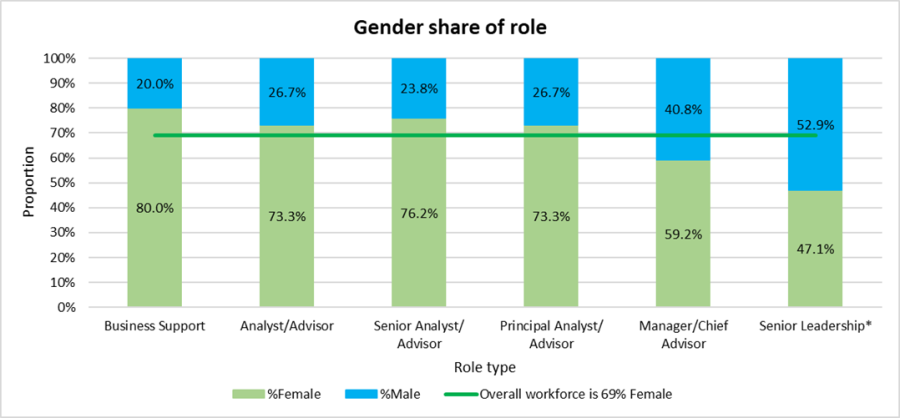Create a fairer workplace with equitable pay and people practices that are free from bias
Gender Pay Gap
- The small Te Kawa Mataaho workforce size means that our gender pay gap can be volatile, with a small number of changes having the potential to have a significant impact.
- The Commission is unusual in that our structure includes three tier 1 statutory officers (the Public Service Commissioner and two statutory Deputy Public Service Commissioners) who are excluded from our organisational gender pay gap calculation. As both our Deputy Public Service Commissioners are female, removing their salaries significantly reduces the overall female average salary.
- Our average (mean) gender pay gap increased between 30 June 2022 and 30 June 2023 by 1.2 percent to 12.3 percent as shown in the top chart below. The key driver behind this is gender representation and the distribution of our relatively small proportion of male employees (31%) across the organisation. For example, there is a larger concentration of women in business support and early-in-career advisory roles (males make up only 24.4% of business support and analyst/advisor-level roles) whereas males have a higher representation in more senior roles - while our senior leadership and management group* is 52.5% female and only 47.5% male, the men in the senior leadership and management group make up 30.2 percent of the total men in our organisation, while the women represent only 14.9 percent of the total women. *Our senior leadership and management group comprises tiers 2 and 3, including people leaders and assistant commissioners but not chief advisors


*Senior leadership includes deputy commissioners and assistant commissioners but excludes the three tier 1 statutory officers (Public Service Commissioner and two Deputy Public Service Commissioners). Both of the Deputy Public Service Commissioners are female, resulting in a tier 1–3 composition that is 53.5 percent female.
Manager and chief advisor roles are combined in this chart due to the small number of chief advisors. Chief advisors provide ‘thought leadership’ but are not people leaders. Data includes employees identifying as female or male but does not report unknown or other genders.
Gender share data is at 30 June 2023
Create a fairer workplace with equitable pay and people practices that are free from bias
Ethnic pay gaps
As a small agency, we have fewer people of most ethnicities than would normally be reported. StatsNZ and workforce guidance recommends reporting pay gaps only where there are more than 20 people in each group, to help protect privacy and produce robust measures (because pay gaps can be volatile over time when measured for small numbers of employees).
The table below depicts the pay gap for Māori, Pacific and Asian employees.
|
Ethnic Pay Gap |
2022 (mean) |
2023 (mean) |
2022 (median) |
2023 (median) |
|---|---|---|---|---|
|
Māori Pay Gap |
-8.8% |
-3.0% |
1.2% |
0.6% |
|
Pacific Pay Gap |
14.60% |
10.5% |
11.60% |
5.0% |
|
Asian Pay Gap |
- |
25.5% |
- |
20.4% |
The difference between mean and median pay gaps is because mean pay can be influenced by a small number of employees with higher pay, whereas the median is less affected by outliers.
Of note:
- We have reviewed pay to ensure it is equitable for those in same or similar roles.
- We have a negative Māori pay gap which means that on average, Māori employees earn more than non-Māori employees due to higher representation at leadership levels. However, with an increase of Māori employees in our general workforce, we expect this may change in the shorter term.
- We are able to report on our Asian pay gap for the first time in 2023 due to an increase in numbers, however we have too few employees of other ethnic backgrounds (such as Middle Eastern, Latin American and African) to report on.
- We understand the driver of our Pacific pay gap to be driven by representation at different role levels causing a difference in average pay. We have made progress towards closing our mean Pacific pay gap from 14.6% in 2022 to 10.5% in 2023, as shown on the chart below.
Transparency
- In 2022, we introduced further changes and transparency to our remuneration framework by implementing step-based progression for roles up to, and including, Senior Advisors. This framework ensures criteria are transparent, we recognise experience, and we minimise discretion.
Equitable pay outcomes
- We have ensured that starting salaries and salaries for the same or similar roles are not influenced by bias, and continually monitor to ensure pay gaps in same or similar roles do not reopen.
- Along with other public sector agencies, we are participating in the Clerical and Administrative Pay Equity claim process.
Effective career and leadership development
- We remain committed to early-in-career programmes that focus on Māori, Pacific and ethnic communities. We employed three interns from Tupu Toa and Tupu Tai in 2021/22, and we continue to participate in the Ethnic Communities Graduate Programme.
- These programmes are increasing the diversity of our workforce, and several past interns are now permanently appointed and contributing to our mahi.
Eliminating bias and discrimination in people policies and practices
- In 2021, we introduced a revised internal policy engagement approach. This process invites all employees to give feedback on existing and proposed policies.
- As part of the policy review engagement process, the People Team undertook extensive staff engagement on key people policies (including Maintaining a Positive Workplace and Speaking Up). Both policies are a key component in delivering a positive and safe workplace culture.
Flexible by default
- In July 2023 people leaders reported that 98% of employees use some form of flexible work. This is an increase on the 90 percent of people reported in 2021 Te Taunaki |Public Service Census.
- We continue to build on our hybrid working operating model. We aim to provide our people with the flexibility, tools, and equipment to help them to do their best work in a modern, vibrant, and collaborative working environment. Hybrid working means that our people can continue to be highly productive and connected, no matter their place of work. Enabling hybrid work supports our ‘flexible-by-design’ goal, as part of our value proposition.